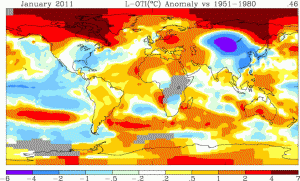“Well,” declared Joe Average Citizen as he stared at his TV and watching anomalously high snowfall rain down on much of the U.S., “I guess global warming is over!” This simple statement, uttered by at least two people within earshot of me in the past two weeks (and likely by countless others in the U.S.) represents several of the mistakes people commonly make regarding global climate change:
- It’s “global climate change,” not global warming – some places may get colder, others warmer, but overall weather patterns – climate – will change.
- Weather and climate are not the same thing
- Cyclic weather extremes (e.g. El Nino or La Nina) happen, but what matters are long-term average climate effects ACROSS the globe, and certainly not just in one or another narrow geographic region (e.g. a continent is too small).
Yes, the U.S. has been pummeled by snowfall this year. A few weeks ago, my father noted that Connecticut is 44 inches above its average snowfall number for Jan/Feb. The normal average is less than 10 inches. This is a 400% increase in snow fall.
So is climate change over? Alas, no. A quick search of Google for live climate data yields the NASA Global Surface Temperature Analysis [1]. You can enter in a month of data you want to chart and compare that data to long-term temperature averages. I chose to plot January temperature data for the globe and compare it on a map to average data from 1951-1980. The red spots indicate anomalously HIGH temperatures, the blue spots anomalously LOW temperatures. We see that the U.S. was in quite a cold snap in January, 2011. But Europe was in a hot snap. At their extremes, parts of the U.S. were 4 degrees Celcius below average, and parts of Europe were 4-7 degrees Celcius ABOVE normal. In part of Europe, people might argue the opposite: global climate change is accelerating (if one equates only heating with that change). I watched Swiss students boarding planes to the U.S. to go skiing in January. That’s not the usual trend for skiing this year; in fact, it’s usually quite the other way around.
What’s the message? Don’t mistake weather for climate. Don’t mistake change for warming. Don’t mistake one year’s harsh weather as a clear sign of all future years. Respect science, respect data, and be careful about making personal or political policy statements based on narrow-scope, cherry-picked, short-term data. It’s not the end (the “nend”) of global climate change.


